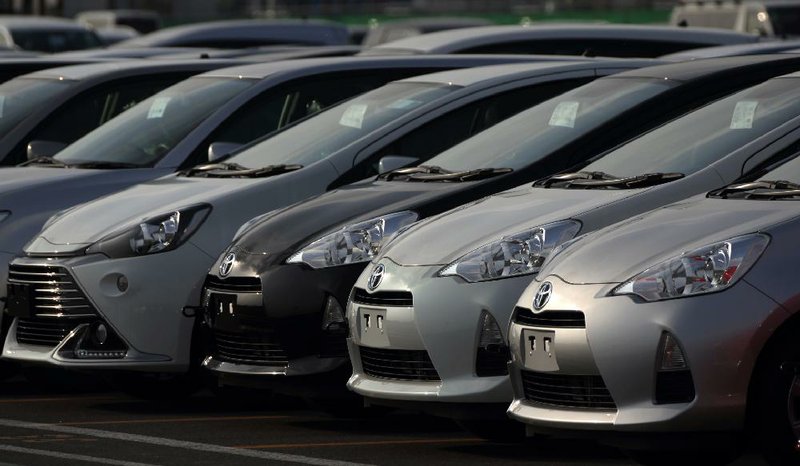TOKYO - Toyota Motor Corp., about to report a record $19 billion profit, can afford the $1.2 billion fine levied by the U.S. government for hiding information about defects in its cars. If anything, the settlement provides relief for Toyota shareholders and customers as a sign the automaker has survived the ordeal.
Toyota President Akio Toyoda declined to comment directly Thursday on the U.S. settlement, in which the Japanese automaker said it hid information about defects that had caused unintended acceleration in Toyota and Lexus vehicles, resulting in injuries and deaths.
All that Toyoda told reporters was what he has repeatedly said before: “We have returned to basics and are putting customers first.”
He said he had nothing to add to a company statement that said it had changed its operations to become more responsive.
A New York judge approved the settlement Thursday, allowing Toyota to pay the fine and dodge confronting a criminal charge that it defrauded consumers by issuing misleading statements after defects caused Toyota and Lexus vehicles to accelerate unexpectedly and cause injuries and deaths.
Federal Judge William H. Pauley III scolded Toyota, saying the case demonstrates that corporate fraud can kill. And he urged prosecutors to continue to investigate the individuals who were responsible.
The company faces a criminal wire-fraud charge in New York that prosecutors say they will move to dismiss in three years if Toyota complies with the terms of the deal.
The recall fiasco has prompted Toyota to take measures, including empowering regional management, speeding up checks into complaints and taking more care and time with product development.
Starting in 2009, Toyota announced one recall after another for a variety of problems, including sticky gas pedals, faulty brakes and ill-fitting floor mats, that eventually covered more than 14 million vehicles. The $1.2 billion fine is the largest of its kind ever imposed on an auto company.
“Toyota can now bring the curtain down on the whole affair and focus on its real business,” said Shigeru Matsumura, analyst with SMBC Friend Securities Co. “Its momentum is back in the U.S.”
When the recall mess began, Toyota was still reeling from the hit it took from the global economic slowdown after the collapse of Lehman Brothers.
More recently, Toyota was badly hurt by the earthquake and tsunami disaster in northeastern Japan in 2011, which destroyed suppliers of components and disrupted car production.
These days, Toyota is on a roll. It has been helped by a weakening of the yen, which increases the value of overseas earnings for Japanese exporters.
Toyota, which makes the Prius hybrid, Corolla subcompact and Lexus luxury models, is expecting a record profit of $19 billion for the fiscal year ending March 31, a doubling of profit from the previous fiscal year.
Sales are doing so well that Toyota, the No. 1 automaker in the world in vehicle sales for the past two years, says it’s on its way to selling more than 10 million vehicles a year - a feat never accomplished in auto history.
There is also a chance Toyota could benefit from the U.S. government investigation into General Motors Co., which is beginning as Toyota’s ends, allowing Toyota to grab market share in the U.S., although manufacturers such as Ford Motor Co. that make models similar to GM are the more likely beneficiaries.
The U.S. market is still a big moneymaker for the world’s automakers. But they are all trying to grow in other markets, such as China. Toyota may face unexpected obstacles in other markets, even as it gets over the U.S. crisis.
Toyota suffered a sales drop in China in 2012, a result of anti-Japanese sentiment over a territorial dispute.
Toyota officials are still banking heavily on China, where a government decision to support hybrid vehicles to counter pollution could work as a plus for Toyota, a leader in hybrid technology.
Potholes wait elsewhere in the world as shown in the lockout of workers at Toyota’s India plants, outside Bangalore, which began this week over a wage dispute.
Even good fortune can prove frightening.
Toyota is doing so well that some superstitious pessimists are pointing to the 10 million vehicle mark as a possible omen, Matsumura, the SMBC analyst, said jokingly.
It was right after then-president of Toyota, Katsuaki Watanabe, announced a sales target of 10 million vehicles that quality lapses began to increase.
Satoru Takada, analyst at Toward the Infinite World Inc., a research firm in Tokyo, laughs at the idea, noting the global pie is growing as sales expand in emerging markets and 10 million vehicles no longer sound highly ambitious.
“That will just be another passing milestone for Toyota. Next, it’s going to be 20 million vehicles,” he said. “What counts for Toyota is that it avoided further criminal consequences. It’s over. I am sure it feels totally refreshed.”
Business, Pages 27 on 03/21/2014
